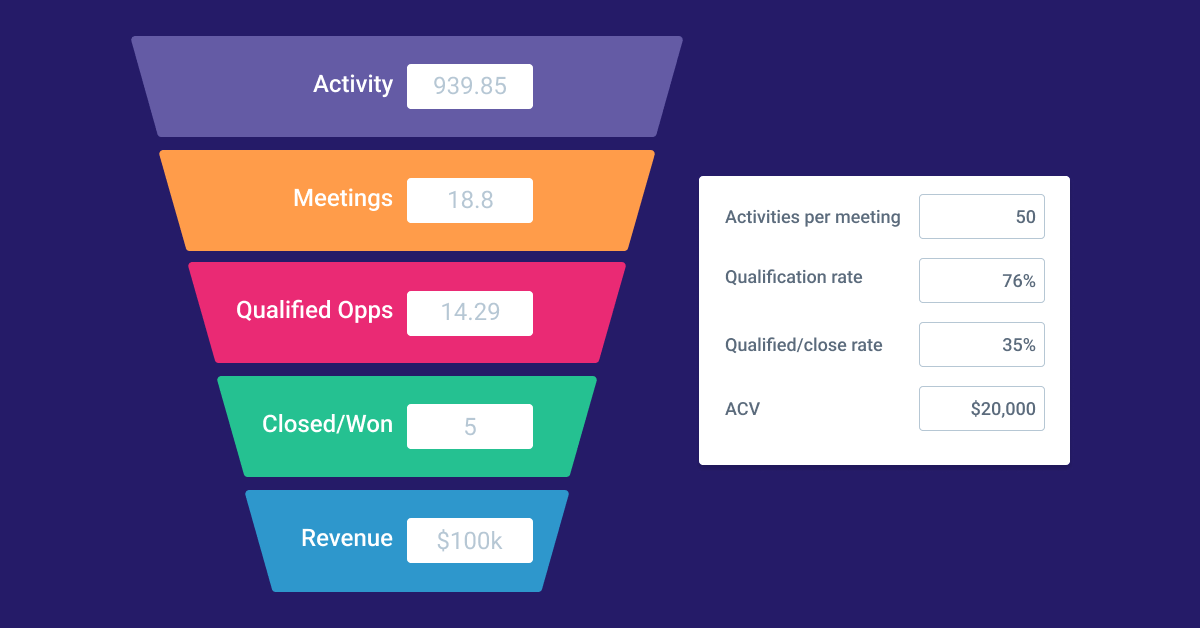Now that we’ve set the quota for SDRs, it’s time to talk about how to set their bonus and commission rates.
Before we dive in, let’s define some terms:
Commission: a percentage of some other number (usually revenue) that you earn. Do you receive some percentage of every deal you bring in? If so, that’s a commission.
Bonus: a flat value you earn for doing something. Do you earn some set amount of money for hitting your quota, hitting revenue milestones, or for every meeting you set? If so, that’s a bonus.
Model and Measure SDR Comp Plans
With QuotaPath, draft your SDR comp plan proposal and test it against past data to see how your SDR would perform and how much you would pay. Then, use Plan Performance Modeling to estimate team attainment and predict how much you’d pay in the coming year according to plan.
Talk to SalesCommission Types
- Single rate commission: The simplest form of commission is the single rate commission. This means that you earn a set % of your sales, regardless of your quota attainment.
- Multiple rate commission: Multiple rate commissions change depending on some variable. The most traditional multiple rate commission is an accelerator that increases your commission rate when you hit your quota.
Bonus Types
- Single rate bonus: Much like a single rate commission, single rate bonuses are very simple. You get paid a specific amount for completing some action. These are more common for non-revenue producing roles, but examples might be earning a flat $500 for closing any deal or earning a bonus for every new logo you close.
- Multiple rate bonus: Again, similar to a multiple rate commission, a multiple rate bonus means that the amount you earn for completing an action changes depending on some other variable like quota attainment.
- Milestone bonus: Milestone bonuses are bonuses you earn for hitting some achievement. For example, you could earn $500 for making 1,000 dials in a month. If you make 999 dials? No bonus. If you make 2,000 dials, you still earn just the $500.
So how do you actually set a bonus and commission rate? Well, once you have your On-Target Earnings (OTE) and quota figured out, you need to determine the weight of each of their quotas on their variable pay. A good rule of thumb is to not tie more than 25% of SDRs’ variable pay on revenue, so we’ll say 75% of their variable pay is earned through demo setting and 25% is earned through revenue generation. From there, it’s fairly simple to work backward. Continuing the example from this blog post, let’s say we have a 20 demo/month and $36k/month revenue quota, an OTE of $72k broken into $40k base and $32k variable. In that example, 75% of the $32k/year would be $24k/year or $2k/month. If you’re paying a flat rate per demo, that would be $100 per demo.

Build a Sales Funnel
Use our free sales funnel resource to see how many meetings your team needs to book to hit quota.
Calculate NowHowever, if you want to incentivize overperformance, you could add an accelerator past 100%. I recommend having your accelerators apply to all demos for the month to add an extra incentive. So maybe you’d want to have your reps earn $100 for every demo up to quota, but once quota has been achieved, they earn $120 for every demo held that month. We’ve seen as many as 100 different earnings tiers, but we recommend sticking with 4 max.
Then if you’re paying 25% of their variable pay on their revenue generated, that would be $12k/year or $1k/month. At a quota of $36k/month, that would be 2.77% of any revenue they generate. I’m a fan of round commission percentages personally, so I’d round it to an even 3%.
At the end of the day, you’ll have to play around with all the numbers and find something that works for your organization.
For additional resources designing SDR comp plans, visit our free tool Compensation Hub. Explore SDR compensation plan examples, customize them to your business, and save and share with your team.



